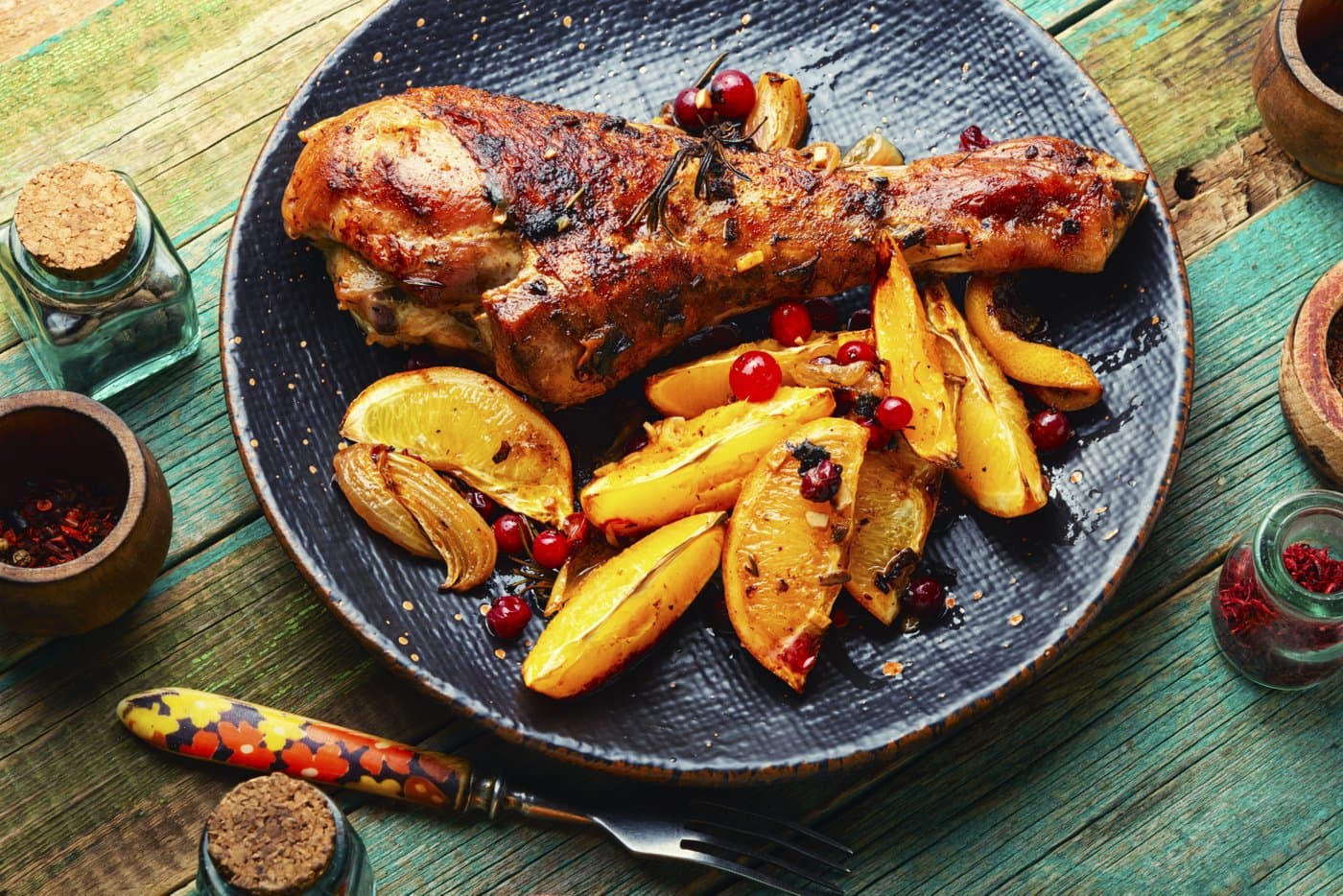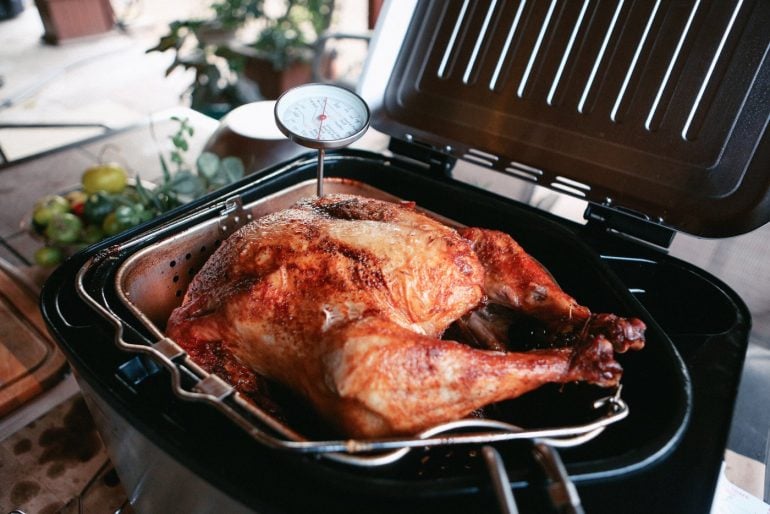You know those shrimp you love to deep fry in the summer? Well, don’t put the deep fryer away in the fall. Keep it out to cook your Thanksgiving turkey!
Frying a turkey may sound like a strange concept, but it doesn’t come out like you’d think. Deep fried turkey is moist and delicious, and not at all greasy. In the hot oil, the turkey’s skin sears quickly, keeping the inside juicy.
Adapted from an article by Cheri Sicard
As you might expect, the idea for deep-fried turkey originated in the south — the frying capital of the United States — but has quickly gained popularity nationwide.
In fact, one block party I attended in South Central Los Angeles had three fried turkeys going. Several groups of neighbors had gotten together and split the cost of the oil and special equipment needed to make this dish, and their tables were some of the most popular.
Here are tips from experts all across America on how to safely fry a delicious turkey dinner.
What you will need to deep fry turkey
- A turkey
- a fryer pot with a basket or frying rack/grab hook plate
- portable gas burner
- a propane gas tank
- candy thermometer
- meat thermometer
- oil (probably 6-8 gallons)
- marinade or spice rub (optional)
- marinade injector (optional)
- fire extinguisher (dry chemical kitchen/grease type)
- silicone gloves or plenty of pot holders
Choosing a turkey: As far as the turkey itself goes, smaller birds work better for frying. Before you buy your turkey, check the instructions for your turkey fryer. Most fryers will accommodate a 12-16 pound turkey. A larger turkey will not fit in the fryer or will take too long to cook. If you need a lot of meat, cook two turkeys, one after the other.
Choosing the oil: Only use oils that have high smoke points, such as peanut oil, refined canola oil, corn oil, rice oil and sunflower oil.
For marinade: An injector to add marinades and seasonings to give the meat more flavor is nice to have, although you can make a plain turkey without it.

Basic turkey prep
- Make sure the turkey is completely thawed before you cook it. (See some important precautions, and a video called “Deep-fried turkey explosion,” below.)
- Remove all of the wrapping, netting, etc. from your turkey.
- Remove the hock lock (metal or plastic thing holding the legs together).
- Take out any pop-up timer from the turkey.
- Remove the giblets and neck from the cavity.
- Cut off the wing tips up to the first joint, and cut off the tail.
- Pat the turkey dry, inside and out, in order to prevent oil splattering when it’s submerged in the hot grease.
- Be sure the metal basket/frying rack/grab hook is clean, completely dry, and ready to go.
Marinades, rubs and other turkey treatments
Rule number one: Don’t stuff a turkey that you’re going to fry.
Before cooking, you can inject the turkey with your favorite marinade, rub it with a dry spice rub, or coat it in seasoned bread crumbs. Use any seasonings that you like. A heavy spice rub of something like Creole spices, black pepper or lemon pepper can be applied both inside and outside the bird.
Prepared marinades, available from the grocery store, can also be injected into the meat before cooking to add juiciness and flavor. Use a marinade injector syringe, available online or from a grocery store, to inject marinade.
A 10-pound turkey should be injected with about 16 ounces (or 2 cups) of marinade, suggests Sarah G Birkhold, Assistant Professor and Extension Poultry Specialist, The Texas A&M University System. (As you might imagine, you should use more marinade on larger birds, and less on smaller birds or cuts of poultry.)
On whole birds, inject about 60 percent of the marinade into the breast muscles, 30 percent into the muscles of the legs and thighs, and 10 percent into the wings. Do not simply inject the marinade under the skin because, as the skin cooks, the water-based marinade will cause the hot oil to pop and splatter. Likewise, do not marinate by soaking the turkey, because this will create lots of hot oil spatter when frying.
After adding marinades and/or seasonings, the National Turkey Federation recommends you place the turkey in a clean roasting pan on the countertop for 30 to 45 minutes. This will allow the marinade and seasonings to permeate the turkey and raise the turkey’s internal temperature, so there will be less splatter during the frying process. (Do not leave it out any more than 45 minutes, though, or you risk food poisoning.)
Since it takes about 45 minutes for the oil to reach the proper temperature, you may want to start the final turkey prep around the time you turn on the burner.

Where to fry
Because hot oil is highly flammable, you should never fry a turkey indoors. Place the fryer outdoors on a level dirt or grassy area. Avoid frying on wood patios or decks, which could catch on fire. You will also want to avoid concrete surfaces, unless you don’t mind oil stains.
State Farm notes that fire departments around the US respond to more than a thousand fires each year in which a deep fryer is involved, while the National Fire Protection Association says deep fryer fires result in more than $15 million in property damage each year — as well as serious, and even life-threatening, burn injuries.
Find out more about what to do in case of a burn in our article Deep-frying turkey? Don’t get burned by lack of knowledge.
If you choose to fry a turkey, follow these safety guidelines:
- Make sure there is at least 2 feet of space between the liquid propane tank and fryer burner.
- Place the liquid propane gas tank and fryer so that any wind blows the heat of the fryer away from the gas tank.
- Place fryer in an open area away from all walls, fences, or other structures.
- Never use in, on or under a garage, breezeway, carport, porch, or any structure that can catch fire.
- Always be sure to follow all of the manufacturer’s instructions for using your cooker, and to check all fittings for leaks before using.
In the event of a grease fire, never use water to put out the fire, because water can cause flaming oil to splatter and spread. A kitchen fire extinguisher or covering the fryer with a metal lid are good ways to put out a grease fire — but keep your phone handy in case you need to call 911.
How to measure for the amount of oil
Before beginning, you will have to determine the amount of oil you’ll need for your particular fryer pot. You should follow the manufacturer’s instructions to determine the correct amount of oil to add. If those are not available, try the water method outlined below — but be sure to measure for the oil before you marinate or put rub on the turkey, because you have to submerge the turkey in water to get the right level.
Deep fried turkey; Water measurement method
- Place your turkey in the empty pot, with the legs up.
- Fill with water until the turkey is completely submerged, covered by 1 to 2 inches of water.
- Do not fill the pot more than 3/4 full, as the oil level should be three inches to five inches from the top of the fryer. Do not over-fill!
- Mark the water level with a ruler to measure the distance from the top of the pot to the surface of the water.
- Remove the turkey, allowing the water to drain from the turkey.
- Thoroughly dry the interior and exterior of the bird to reduce spattering when you fry.
- Dump out the water (it will have bacteria in it, so don’t reuse it) and thoroughly dry the pot.
- If the fryer has a drain valve, be sure there isn’t any excess water in the spigot. Open the valve to drain the water and remember to close the valve before adding oil.
- Make sure the fryer is turned off, is away from water sources, and is totally dry.
- Fill with oil to the marked level.
Some people recommend doing this measurement while your turkey is in a plastic bag. If you do it this way, check that there’s not any extra air in the bag, and also make sure to account for the volume of oil that will fill the turkey cavity.
How to deep fry turkey
- Heat the oil to 375 to 390 degrees F before lowering the bird into the hot oil, says Poultry Specialist Sarah G Birkhold at Texas A&M University. Use a candy or oil thermometer to get the temperature just right. (The initial heating process usually takes between 45 minutes to an hour.)
- Once the oil is hot enough, shut off the fuel source or flame when adding the turkey to the hot oil to prevent a dangerous flare-up if oil does spill over the rim.
- Place your the turkey in the basket or on a frying rack with the feet pointing up.
- For safety reasons, it is best to have two people to slowly lower and raise the turkey. Do not just dunk the turkey in the oil. To avoid the oil bubbling over, gradually lower the turkey into the hot oil, slowly pull it back out, and repeat until it is fully immersed. (Note that the oil will drop to around 350 degrees F when the bird is first immersed.)
- While someone else watches the pot, go wash your hands, utensils, equipment and surfaces that have come in contact with raw turkey to avoid cross contamination.
- Turn the burner back on, and make sure the oil is at 350 F. Do not use a lid while frying.
- Cook turkey for around 3-1/2 minutes per pound at 350 degrees F. Use a timer. (For example, a 10-pound bird would cook for about 35 minutes at 350 F.)
- Monitor the temperature of the oil with a thermometer constantly during cooking. Never leave the hot oil unattended!
- The National Turkey Federation says to be sure to keep the oil temperature above 340 degrees F, or oil will begin seeping into the bird, making for a greasy turkey.
- If the oil temperature rises to 375 degrees F, reduce cooking time to 2-1/2 to 3 minutes per pound. If the temperature drops below 350 degrees, adjust the burner to increase the heat.
When the turkey is done
- Although you need to time your turkey’s cooking time carefully, based on its weight and the oil temperature, you might be able to tell when it’s almost done because it may start to float.
- When the time is up, slowly and carefully remove the turkey or other poultry from the oil (remember: for safety reasons, have two people lowering and raising the turkey). If possible, hold it over the fryer for a few moments so some oil can drain out.
- Check the temperature of the turkey with a food thermometer. The turkey is safely cooked when the food thermometer reaches a minimum internal temperature of 165 F to 170 F in the breast, and 175 F to 180 F in the thigh.
- If the turkey is not done, immediately return the turkey to the hot oil for additional cooking.
- When the turkey is fully cooked, remove it from the oil and after letting some oil drain back into the fryer, place it on a sturdy tray lined with paper towels.
- The turkey may look darker than you’re used to, if you’re comparing to a typical roast turkey. The skin can be golden, dark brown, or even almost black. This is normal for a deep-fried turkey.
- Cover the bird with foil and let it rest about 20 minutes before carving.
- It’s dinnertime! Eat your cooked turkey immediately, and store leftovers in the refrigerator in shallow containers within two hours of cooking to promote rapid, even cooling.
- Use your refrigerated turkey leftovers for three to four days, or freeze after wrapping in freezer paper or heavy-duty foil, or putting in freezer bags or freezer containers. For best quality, use frozen leftovers within three to four months.
Don’t forget about the oil
Once the turkey is out, remove the pot from the burner and move to a flat, safe place, cover it, and allow the oil to cool overnight. Remember that it will be hot and dangerous for probably at least several hours, so make sure it’s out of the way, and that kids and pets don’t get curious.
Once the oil has cooled, you can strain out the solids and use it again. Get the details about storing and reusing turkey fryer oil here.
Important turkey frying safety tips
- Center the pot over the burner on the cooker.
- Raise and lower food slowly to reduce splatter and avoid burns.
- Cover bare skin when adding or removing food.
- Keep fryer in full view while burner is on. Never leave the hot oil unattended.
- Don’t allow children or pets near the cooking area.
- Check the oil temperature frequently.
- If oil begins to smoke, immediately turn gas supply off.
- If a fire occurs, immediately call 911. Do not attempt to extinguish fire with water.
Deep-frying turkey? Don’t get burned by lack of knowledge
Each November, you can’t open a magazine or website without finding dozens of tips on how to create the perfect deep-fried turkey.
But do you know that Thanksgiving is the most dangerous day of the year in the kitchen? And do you know what to do if your deep-frying backfires, and burns you with boiling oil?
Here’s an easy reminder: Everything “common sense” tells you about caring for serious burns is probably wrong. You can trust grandma’s tips for deep-frying holiday treats such as Swedish rosettes… but when it comes to treating deep-fryer burns — which are among the most serious household burns — you need advice from experts.
“Deep-fryer burns are some of the most serious burns we treat, because the oil can be as much as 400 degrees, and can cling to clothing, making the burns even deeper,” says Dr Lee Faucher, director of the Burn Center at University of Wisconsin Hospital and Clinics. “It is not uncommon for deep fryers to create third-degree burns that require skin grafts to heal.”
Caring for serious burns
The National Fire Protection Association (NFPA) says that Thanksgiving is the most dangerous day of the entire year for home-cooking fires, so it’s a good time to bone up on burn-care facts.
Here are some common myths about caring for serious injuries caused by deep fried turkey burns.
1) It looks bad but it doesn’t hurt, so it’s probably okay, right?
Wrong. Some burns, especially from burning fat, are so severe that they destroy nerves in the area of the burn, leading to a lack of sensation.
“A blistered burn without sensation means that you should seek medical attention immediately,” says Dr Faucher. “This is a sign of a deep injury that has damaged the superficial nerves of the skin and is a marker of a more serious burn.”
2) It really hurts, so I should take lots of painkillers, right?
Wrong. “Again, you need to be evaluated by a burn specialist, because if you are going to need skin-graft surgery, there are some painkillers that need to be avoided because they promote bleeding that could interfere with surgery,” Faucher says. “We prescribe medications such as ibuprofen when we know the wound will heal without surgery.”
3) A serious burn should be left open to the air so it can heal, right? Wrong.
“We usually want patients to keep burns covered with a light dressing to hold the antimicrobial cream. The burn needs to stay moist and not allowed to dry out to allow it to heal properly,” says Faucher. “In addition, we wrap more serious burns with ace wraps or compression gloves to reduce edema.”
4) A serious burn should be kept dry, right?
Wrong. Faucher says that the slime covering a healing third-degree burn is the perfect breeding ground for dangerous bacteria. “When patients have an open wound from a burn, they need to wash the wound thoroughly with soap and water at least once a day,” he says. “This can be terribly painful, so we often prescribe pain killers so they are able to complete this necessary washing.”
Find out about the different types of burns: Hot stuff: Burn basics
Of course, the best treatment is to prevent deep-fryer burns in the first place. Faucher notes that the NFPA discourages the use of outdoor gas-fueled turkey fryers. The association’s website has a list of other tips for making the kitchen safer on Thanksgiving.
“It would be a great holiday for everyone at the Burn Center if we didn’t see a single patient who was burned by holiday cooking,” Faucher says. “Be careful out there.”
Deep-fried turkey explosion (video)
Fire inspectors from the 1st Special Operations Civil Engineering Squadron drop a frozen turkey into a turkey fryer full of hot oil to demonstrate why it can be dangerous. Afterwards, they demonstrate the proper way to deep fry a turkey.








